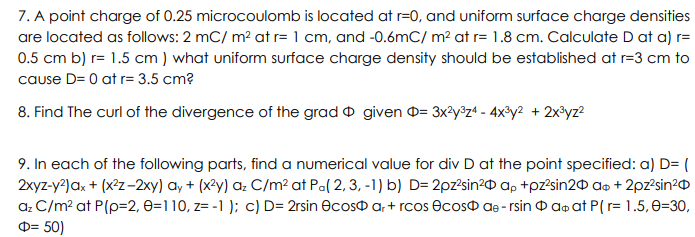7. A point charge of 0.25 microcoulomb is located at r=0, and uniform surface charge densities are located as follows: 2 mC/ m² at r= 1 cm, and -0.6mC/ m² at r= 1.8 cm. Calculate D at a) r= 0.5 cm b) r= 1.5 cm) what uniform surface charge density should be established at r=3 cm to cause D= 0 at r= 3.5 cm? 8. Find The curl of the divergence of the grad given = 3x²y374 - 4x3y² + 2x3v72
7. A point charge of 0.25 microcoulomb is located at r=0, and uniform surface charge densities are located as follows: 2 mC/ m² at r= 1 cm, and -0.6mC/ m² at r= 1.8 cm. Calculate D at a) r= 0.5 cm b) r= 1.5 cm) what uniform surface charge density should be established at r=3 cm to cause D= 0 at r= 3.5 cm? 8. Find The curl of the divergence of the grad given = 3x²y374 - 4x3y² + 2x3v72
Introductory Circuit Analysis (13th Edition)
13th Edition
ISBN:9780133923605
Author:Robert L. Boylestad
Publisher:Robert L. Boylestad
Chapter1: Introduction
Section: Chapter Questions
Problem 1P: Visit your local library (at school or home) and describe the extent to which it provides literature...
Related questions
Question
Note: Please write neatly, and answer with complete solution. Thank you

Transcribed Image Text:7. A point charge of 0.25 microcoulomb is located at r=0, and uniform surface charge densities
are located as follows: 2 mC/ m² at r= 1 cm, and -0.6mC/ m² at r= 1.8 cm. Calculate D at a) r=
0.5 cm b) r= 1.5 cm) what uniform surface charge density should be established at r=3 cm to
cause D= 0 at r= 3.5 cm?
8. Find The curl of the divergence of the grad given = 3x²y³z4 - 4x³y² + 2x³yz²
9. In each of the following parts, find a numerical value for div D at the point specified: a) D= (
2xyz-y²) ax + (x²z-2xy) ay + (x²y) az C/m² at Pa(2, 3, -1) b) D=2pz²sin² ap+pz²sin20 a + 2pz²sin²
az C/m² at P(p=2, 0=110, z= -1); c) D= 2rsin Ocos ar+rcos ecos de- rsin ao at P(r= 1.5, 0-30,
= 50)
Expert Solution
This question has been solved!
Explore an expertly crafted, step-by-step solution for a thorough understanding of key concepts.
Step by step
Solved in 4 steps with 3 images

Knowledge Booster
Learn more about
Need a deep-dive on the concept behind this application? Look no further. Learn more about this topic, electrical-engineering and related others by exploring similar questions and additional content below.Recommended textbooks for you

Introductory Circuit Analysis (13th Edition)
Electrical Engineering
ISBN:
9780133923605
Author:
Robert L. Boylestad
Publisher:
PEARSON

Delmar's Standard Textbook Of Electricity
Electrical Engineering
ISBN:
9781337900348
Author:
Stephen L. Herman
Publisher:
Cengage Learning

Programmable Logic Controllers
Electrical Engineering
ISBN:
9780073373843
Author:
Frank D. Petruzella
Publisher:
McGraw-Hill Education

Introductory Circuit Analysis (13th Edition)
Electrical Engineering
ISBN:
9780133923605
Author:
Robert L. Boylestad
Publisher:
PEARSON

Delmar's Standard Textbook Of Electricity
Electrical Engineering
ISBN:
9781337900348
Author:
Stephen L. Herman
Publisher:
Cengage Learning

Programmable Logic Controllers
Electrical Engineering
ISBN:
9780073373843
Author:
Frank D. Petruzella
Publisher:
McGraw-Hill Education

Fundamentals of Electric Circuits
Electrical Engineering
ISBN:
9780078028229
Author:
Charles K Alexander, Matthew Sadiku
Publisher:
McGraw-Hill Education

Electric Circuits. (11th Edition)
Electrical Engineering
ISBN:
9780134746968
Author:
James W. Nilsson, Susan Riedel
Publisher:
PEARSON

Engineering Electromagnetics
Electrical Engineering
ISBN:
9780078028151
Author:
Hayt, William H. (william Hart), Jr, BUCK, John A.
Publisher:
Mcgraw-hill Education,